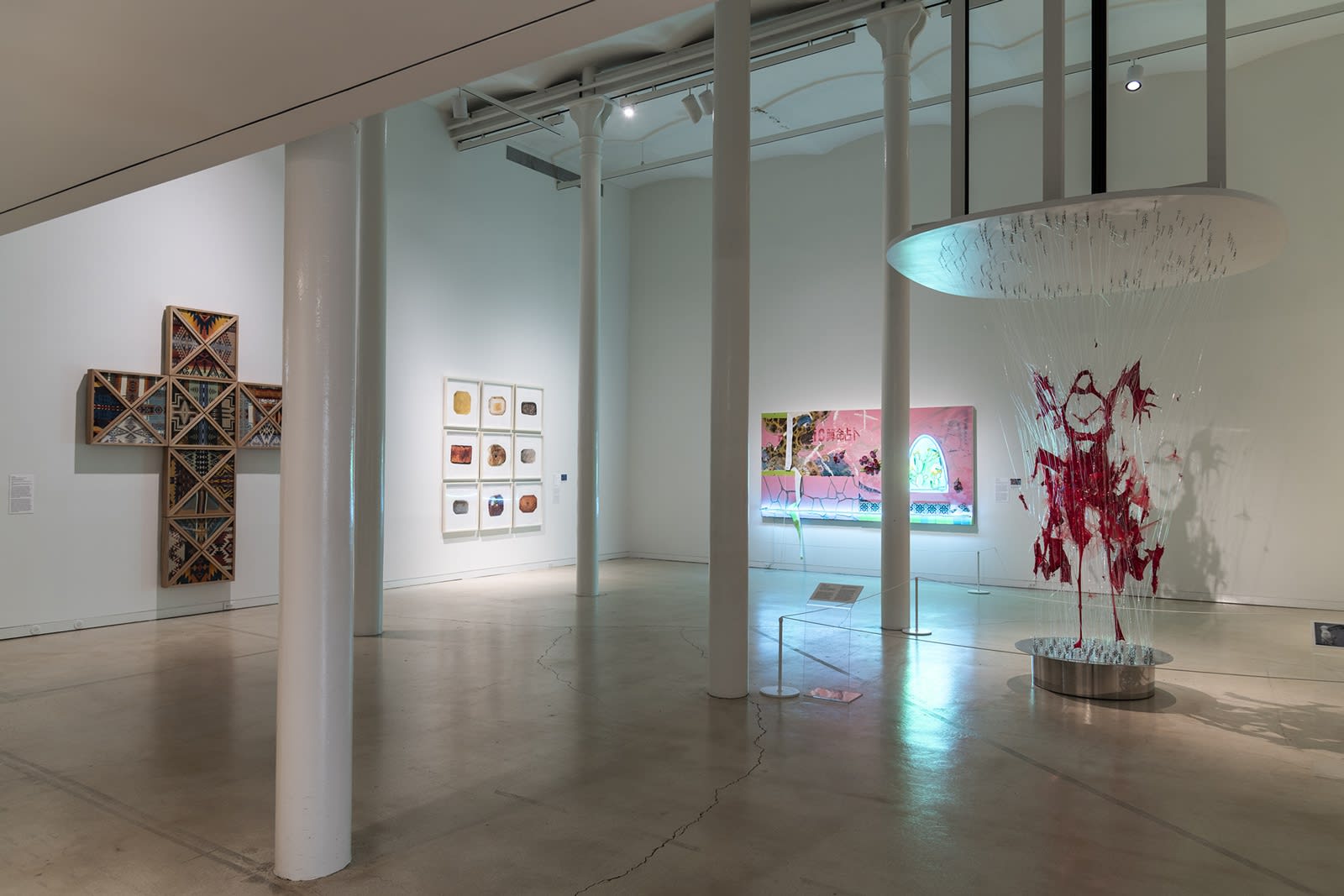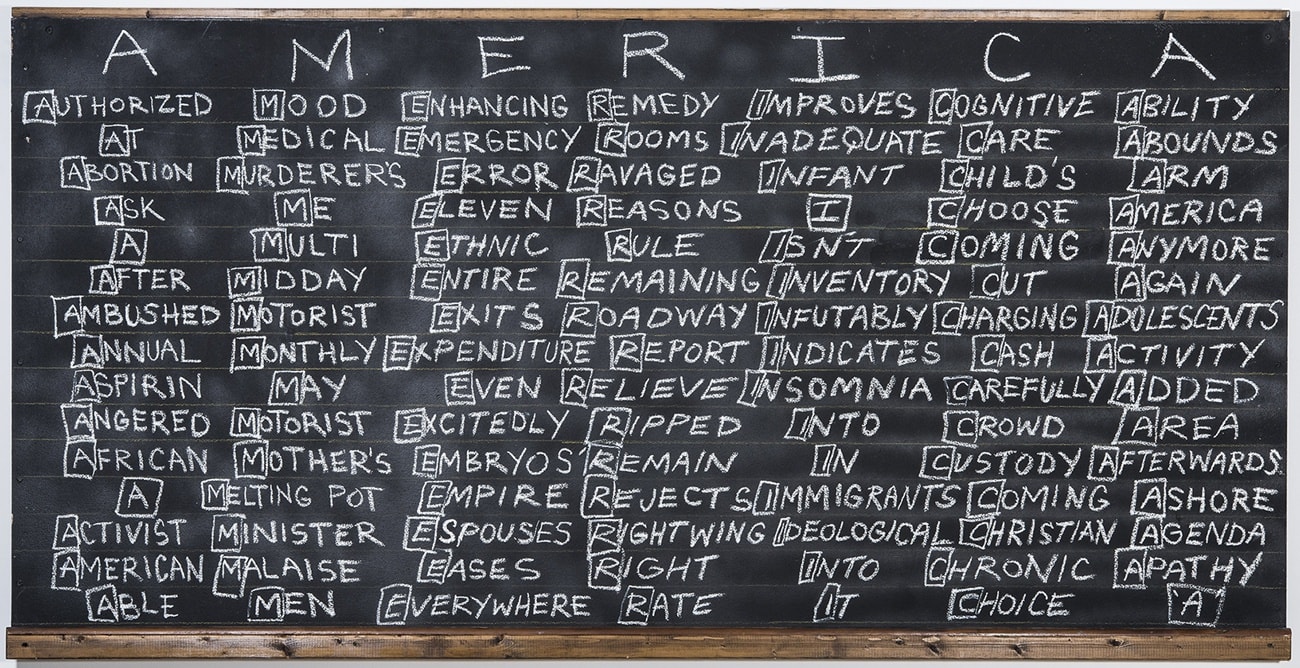In 1917, French artist Marcel Duchamp submitted an upside-down porcelain urinal as a sculpture to the Society of Independent Artists in New York under the pseudonym R. Mutt. The artwork, titled Fountain, was rejected by the Society, whose jury did not consider it to be a true work of art. Duchamp's manipulation of this mass-produced urinal became known as a "readymade." The idea that an artist's creative liberty could be enough to transform pre-made, ordinary objects into art challenged the art world in a way that continues to be relevant.

Installation view of "Readymade Remix: New Approaches to Familiar Objects." Photo: Beth Devillier, courtesy of the San Antonio Museum of Art
More than a century after Duchamp's Fountain, artists continue to transform everyday materials into works of art. Readymade Remix: New Approaches to Familiar Objects at the San Antonio Museum of Art (SAMA) showcases numerous contemporary artworks from the museum's collection that investigate the familiar through mixing objects, repetition, and considering historical context. The result is an exhibition that confronts personal and collective contemporary realities in the United States.
Joe Harjo's The Only Certain Way: Faith showcases Pendleton beach towels with Native American patterns encased in custom memorial flag cases, which are typically used to hold U.S. flags for military service. The 24 triangular cases are assembled to form a cross. These ready-made materials juxtaposed together creates what Harjo calls the "bait-and-switch," where he presents viewers with familiar imagery that challenges initial expectations.
The artwork takes its name from text in La Relación y Comentarios. Written by Spanish explorer Álvar Núñez Cabeza de Vaca, the book documents his early-1500 journeys through what is now the Southwestern U.S. and Mexico. Cabeza de Vaca implies that kindness is the way the Spaniards could convert Native Americans to Christianity. In a 2020 review of another San Antonio presentation of Harjo's work, Neil Fauerso describes that, under the Spanish mindset of the time, "if the gospel is spread truthfully and with compassion, then the rapacious conquest of lands and people is muted, and made somehow okay." Considering this historical context, Harjo's sculpture effectively becomes a memorial for Indigenous lives lost due to colonization and forced assimilation.
Harjo was raised in Oklahoma, and is a member of the Muscogee (Creek) Nation. By repurposing patriotic and religious symbols into a visual language of mourning, Harjo reclaims space for Indigenous memory and resilience, transforming a history of loss into an act of cultural resistance.
Like Harjo, Matthew Angelo Harrison also explores the legacy of colonization in his piece Beloved Worker. The sculpture is an industrial reinterpretation of a Dan face mask. Originating from Côte d'Ivoire and Liberia, these masks are believed to hold spiritual power and are typically used by Dan leaders in ritual and cultural practices.
In Beloved Worker, Harrison transforms this sacred object into a modern artifact - encasing an Exxon hardhat in resin alongside a Dan mask form, and presenting it on an aluminum stand. Raised in Detroit by parents who worked in the U.S. automobile industry, Harrison engages with the legacy of labor by using industrial machines in a distinctly artistic and conceptual way. In doing so, he investigates ancestral heritage and contemporary identity, probing what he calls the "distance of African and African American" psyche.
The uncomfortable reality of how African artifacts came into Western museums is also something to consider. Were Dan face masks, which are highly spiritual artifacts, ever intended to be displayed in museums? With Beloved Worker, Harrison reclaims some of the power stripped away by colonization, confronting the ongoing effects of this legacy on the African diaspora.
Patrick Martinez reflects on contemporary struggles and layered identities in Jaguar Guardian, a mixed-media landscape that commands attention through its vivid contrasts. Neon lights blaze beside a banner of roses, ceramic tiles, graffiti, and thick strokes of paint, all familiar textures for anyone who's walked the streets of Los Angeles. Drawing from the city's visual vocabulary, Martinez blends sculpture and painting to reflect a place shaped by survival, memory, and resistance.
Much like Los Angeles, Martinez's identity is layered. He is Native American, Mexican, and Filipino - giving him an experience that, in his words, catalyzes his desire "to complicate things and to capture those nuances and those complexities." This ethos takes material form in the open-mouthed jaguar on our left side of the composition. Martinez pulls the imagery of the open-mouthed jaguar from murals at the Cacaxtla archaeological site in Central Mexico.
Emerging from the jaguar's mouth, the Chinese characters 算命占卜 (fortune-telling) add another layer of cultural fusion. A cluster of spray-painted roses blooms across the surface - soft yet defiant, evoking both street memorials and sacred offerings. They lead the eye toward a neon prickly pear cactus, an emblem of Mexican identity recast in urban glow. Through these layered symbols, Martinez invites viewers to consider how spiritual knowledge, ancestry, and place take new forms in today's America.

Willie Cole, "How Do You Spell America #6," 1993, oilstick, chalk, and latex on masonite and wood, 49 x 96 inches. San Antonio Museum of Art, purchased with funds provided by The Brown Foundation Contemporary Art Acquisition Fund, Janet L. Brown, the Guillermo C. Nicolas & James C. Foster Art Fund, Christopher C. Hill, Dr. Harmon and Harriet Kelley, Zoe A. Diaz, Stacey Hill and Erick Schlather, and an Anonymous Donor, 2012.17 © Willie Cole
The contrast between Jaguar Guardian and Willie Cole's nearby piece, How Do You Spell America #6, is striking. Cole's iterations of "America" are written in chalk on a blackboard, each carefully composed to form sentences that critique polarizing issues such as healthcare, race, and education when read left to right. One of the phrases of "America" reads: "A Melting Pot Empire Rejects Immigrants Coming Ashore." Cole offers a stinging indictment of American exclusion.
Together, the artworks in Readymade Remix demonstrate how contemporary artists use familiar objects, symbols, and histories to confront complex realities of identity, heritage, and belonging. The artists investigate these concepts in various ways - from Martinez's layered fusion of cultures and spiritual knowledge, to Cole's pointed critiques of systemic exclusion, to Harjo and Harrison's reclamation of Indigenous and African diasporic histories. The exhibition challenges viewers to ask: What does America truly mean? Are we on the verge of repeating history's mistakes, or are we already living through them?
Readymade Remix: New Approaches to Familiar Objects is on view at the San Antonio Museum of Art through April 12, 2026.
Author's Note: Special thanks to Seth Ault for translating the Chinese characters featured in Patrick Martinez's work.

